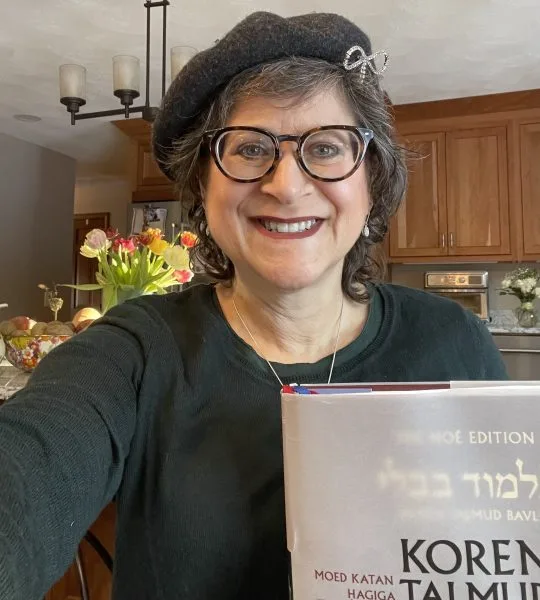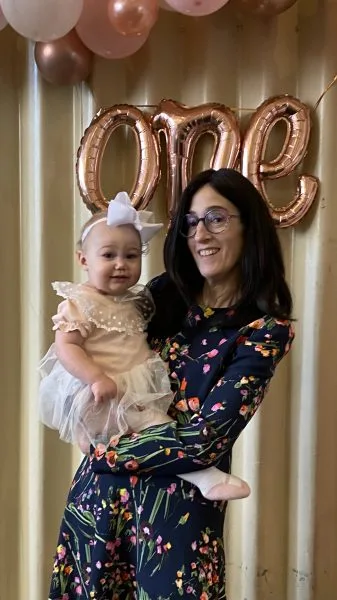Why did the mishna compare the case of two cups of blood to a sin offering that got lost and another was brought in its place? The gemara concludes that the msihna was brought in order to teach a case that can be derived from the mishna and not for the case itself. The mishna brings all sorts of cases where the laws of offering sacrifices outside do not apply either because of the type of offering (that isn’t offered inside the mikdash) or because of the animal brought (a disqualified animal). The mishna describes historically – when were sacrifices allowed to be brought outside the mishkan (bamot) and when were they forbidden? What were the laws regarding each time period (when they were allowed and when they weren’t)? What sacrifices were allowed to be brought anywhere (during the time when bamot were permitted)?
This week’s learning is sponsored by Tina Lamm in loving memory of her father, Mr. Mike Senders, A”H, Yitzchak Meir ben HaRav Tzvi Aryeh v’Esther Bayla, on his shloshim. “Reaching the age of 101 was not only a personal milestone for my father, but also a testament to the fullness of his life. He used those years well – building Torah institutions, nurturing family and living in intimacy with Hakadosh Baruch Hu. יְהִי זִכְרוֹ בָּרוּךְ”
Masechet Zevachim
Masechet Zevachim is sponsored by Esther Kremer in loving memory of her father, Manny Gross on his third yahrzeit. “He exemplified a path of holiness and purity, living with kedushah in his everyday life.”
Want to dedicate learning? Get started here:
This week’s learning is sponsored by Tina Lamm in loving memory of her father, Mr. Mike Senders, A”H, Yitzchak Meir ben HaRav Tzvi Aryeh v’Esther Bayla, on his shloshim. “Reaching the age of 101 was not only a personal milestone for my father, but also a testament to the fullness of his life. He used those years well – building Torah institutions, nurturing family and living in intimacy with Hakadosh Baruch Hu. יְהִי זִכְרוֹ בָּרוּךְ”
Masechet Zevachim
Masechet Zevachim is sponsored by Esther Kremer in loving memory of her father, Manny Gross on his third yahrzeit. “He exemplified a path of holiness and purity, living with kedushah in his everyday life.”
Delve Deeper
Broaden your understanding of the topics on this daf with classes and podcasts from top women Talmud scholars.
New to Talmud?
Check out our resources designed to help you navigate a page of Talmud – and study at the pace, level and style that fits you.
The Hadran Women’s Tapestry
Meet the diverse women learning Gemara at Hadran and hear their stories.
Zevachim 112
גְּמָ׳ בִּשְׁלָמָא בַּחוּץ וְחָזַר וְנָתַן בִּפְנִים – שֶׁכּוּלּוֹ רָאוּי לִהְיוֹת בִּפְנִים; אֲבָל בִּפְנִים וְהֶעֱלָן בַּחוּץ – שִׁירַיִים נִינְהוּ!
GEMARA: The Gemara discusses the first clause of the mishna: Granted that one is liable in a case where he first placed the blood on an altar outside the courtyard and then placed the remaining blood on the altar inside the courtyard; that is because, as the mishna explains: As the blood in its entirety is fit to be placed inside the courtyard. But in a case where he first placed its blood on the altar inside the courtyard and then offered up the remaining blood on an altar outside the courtyard, why he is liable? That blood is merely a remainder, and one should not be liable for offering it up outside.
הָא מַנִּי – רַבִּי נְחֶמְיָה הִיא, דְּאָמַר: שְׁיָרֵי הַדָּם שֶׁהִקְרִיבָן בַּחוּץ – חַיָּיב.
The Gemara explains: In accordance with whose opinion is this mishna? It is in accordance with the opinion of Rabbi Neḥemya, who says: For the remainder of the blood of an offering that was supposed to be poured at the base of the altar and that instead one sacrificed outside the courtyard, one is liable.
אִי רַבִּי נְחֶמְיָה, אֵימָא סֵיפָא: קִבֵּל דָּמָהּ בִּשְׁנֵי כּוֹסוֹת; נָתַן שְׁנֵיהֶם בִּפְנִים – פָּטוּר. שְׁנֵיהֶם בַּחוּץ – חַיָּיב. אֶחָד בִּפְנִים וְאֶחָד בַּחוּץ – פָּטוּר. וְהָאָמַר רַבִּי נְחֶמְיָה: שְׁיָרֵי הַדָּם שֶׁהִקְרִיבָן בַּחוּץ – חַיָּיב!
The Gemara asks: If the mishna is in accordance with the opinion of Rabbi Neḥemya, then say the latter clause: If one collected its blood in two cups and placed the blood from both of them on the altar inside the courtyard, he is exempt. If he placed the blood from both of them on an altar outside the courtyard, he is liable. If he first placed the blood from one cup inside and then placed the blood from the other one outside, he is exempt. By using the blood of the first cup to perform the mitzva of placing the blood on the altar, he thereby rendered the blood in the second cup a mere remainder. The Gemara asks: How can this clause be attributed to Rabbi Neḥemya? But doesn’t Rabbi Neḥemya say: For the remainder of the blood of an offering that one offered outside the courtyard, he is liable?
סֵיפָא אֲתָאן לְתַנָּא קַמָּא דְּרַבִּי אֶלְעָזָר בְּרַבִּי שִׁמְעוֹן, דְּאָמַר: כּוֹס עוֹשֶׂה דָּחוּי לַחֲבֵירוֹ.
The Gemara answers: In the latter clause we arrive at the opinion of the first tanna, who disagrees with Rabbi Elazar, son of Rabbi Shimon. As that tanna says: The placement of the blood from one cup renders the blood of the other cup as disqualified. Since it is actually disqualified and not merely a remainder, one is not liable for offering it up outside.
לְמָה הַדָּבָר דּוֹמֶה? לְמַפְרִישׁ חַטָּאתוֹ וְאָבְדָה, וְהִפְרִישׁ אַחֶרֶת תַּחְתֶּיהָ, וְאַחַר כָּךְ נִמְצֵאת הָרִאשׁוֹנָה.
§ The mishna presents an analogy for its ruling: To what is this matter comparable? It is comparable to a case where one separated an animal for his sin offering and it was lost, and he separated another animal in its place, and thereafter, the first animal was found.
״לְמָה הַדָּבָר דּוֹמֶה״ לְמָה לִי? הָא מַנִּי – רַבִּי הִיא; דְּאָמַר: אֲבוּדָה בִּשְׁעַת הַפְרָשָׁה – מֵתָה.
The Gemara asks: Why do I need to ask: To what is this matter comparable, and provide an analogy to the mishna’s rulings? What does the analogy add? The Gemara explains: In accordance with whose opinion is this mishna? It is in accordance with the opinion of Rabbi Yehuda HaNasi, who says (see Temura 22b): A sin offering that was lost during the time of the separation of a substitute, if it is later found and one of them is slaughtered as the person’s sin offering, the other one is put to death. Accordingly, it is actually disqualified from being used as an offering, and one is therefore not liable for offering it up outside.
וְהָכִי קָאָמַר: טַעְמָא דְּאָבְדָה; הָא הִפְרִישׁ שְׁתֵּי חַטָּאוֹת לְאַחְרָיוּת – חֲדָא מִינַּיְיהוּ מֵעִיקָּרָא עוֹלָה הִיא.
And this is what the mishna is saying by presenting its analogy: The reason that one is exempt from liability for offering up the unused sin offering outside is that it was lost at the time its substitute was separated and therefore it is considered disqualified. But if one separated two sin offerings from the outset as a guarantee, so that even if one is lost he can use the other, then if neither is lost and he sacrifices one of them, the other one is not put to death. Rather, it is left to graze until it becomes blemished, at which point it is sold and the proceeds used to purchase a voluntary burnt offering. It emerges that from the outset, one of these two animals, i.e., the one that was not ultimately sacrificed as his sin offering, is a burnt offering, and therefore if one offers it up outside the courtyard he is liable. The analogy teaches that with regard to blood collected in two cups, if one offers up blood from the unused cup outside, he is exempt only because the blood in that cup is considered disqualified, but he would not be exempt if it was considered a remainder.
וְכִדְרַב הוּנָא אָמַר רַב, דְּאָמַר רַב הוּנָא אָמַר רַב: אָשָׁם שֶׁנִּיתַּק לִרְעִיָּיה, וּשְׁחָטוֹ סְתָם – כָּשֵׁר לְעוֹלָה.
And this is in accordance with the statement that Rav Huna says that Rav says, as Rav Huna says that Rav says: A guilt offering that was consigned to grazing per the halakha to leave it to graze if its owner dies or achieves atonement through another guilt offering, and then instead of being left to develop a blemish, at which point it could be sold and the proceeds used to purchase a voluntary burnt offering, one slaughtered it, even with unspecified intent, the animal itself is fit to be sacrificed as a burnt offering. Similarly, the mishna assumes that in any case where an animal is consigned to grazing it is considered fit, and one would be liable for slaughtering it outside the courtyard.
מִי דָּמֵי?! הָתָם אָשָׁם זָכָר, וְעוֹלָה זָכָר; אֲבָל חַטָּאת – נְקֵבָה הִיא! אָמַר רַב חִיָּיא מִיּוֹסְתִּינְיָא: בִּשְׂעִיר נָשִׂיא.
The Gemara asks: Are these cases comparable? There, in Rav’s ruling, it is logical that the animal is considered fit, as a guilt offering is a male animal and a burnt offering is a male animal, so it is possible to bring an animal as the latter even if it had been designated as the former. Therefore, a guilt offering left to graze is still considered fit. But in the mishna’s case, just because the animal is left to graze does not necessarily indicate that it itself is fit to be brought, as a sin offering is a female animal, which can never be brought as a burnt offering. Therefore, it should be considered unfit. Rav Ḥiyya from Yostiniyya said: The ruling of the mishna is with regard to the goat of the Nasi, which is a male sin offering. Therefore, in a case where it is left to graze it is still considered fit, as it can be brought as a burnt offering.
This chapter discussed two distinct prohibitions: That of slaughtering an offering outside the Temple courtyard and that of offering up an offering by placing it upon an altar outside the Temple courtyard. Since they are considered two distinct prohibitions, one is liable even if he performs only one of them, and he is liable twice if he performs both.
הֲדַרַן עֲלָךְ הַשּׁוֹחֵט וְהַמַּעֲלֶה
מַתְנִי׳ פָּרַת חַטָּאת שֶׁשְּׂרָפָהּ חוּץ מִגִּתָּהּ, וְכֵן שָׂעִיר הַמִּשְׁתַּלֵּחַ שֶׁהִקְרִיב בַּחוּץ – פָּטוּר.
MISHNA: With regard to the red heifer of purification that one burned outside its pit, the pit being an excavation on the Mount of Olives opposite the entrance to the Sanctuary designated for its slaughter and its burning, and likewise the scapegoat that one sacrificed outside the Temple courtyard rather than casting it off a cliff as prescribed, he is exempt from punishment for violating the transgression of slaughtering and sacrificing outside the Temple courtyard.
שֶׁנֶּאֱמַר: ״וְאֶל פֶּתַח אֹהֶל מוֹעֵד לֹא הֱבִיאוֹ״ – כֹּל שֶׁאֵין רָאוּי לָבֹא אֶל פֶּתַח אֹהֶל מוֹעֵד, אֵין חַיָּיבִין עָלָיו.
The source for this is as it is stated with regard to slaughter of sacrificial animals outside the courtyard: “Whatever man…that slaughters outside the camp, and to the entrance of the Tent of Meeting he did not bring it, to present it as an offering to the Lord before the Tabernacle of the Lord” (Leviticus 17:3–4). From that verse it is derived: For any offering that is not fit to come to the entrance of the Tent of Meeting for sacrifice on the altar, e.g., the red heifer and the scapegoat, one is not liable for its slaughter and sacrifice outside its place.
הָרוֹבֵעַ, וְהַנִּרְבָּע, וְהַמּוּקְצֶה, וְהַנֶּעֱבָד, וְהַמְּחִיר, [וְהָאֶתְנַן], וְהַכִּלְאַיִם, וְהַטְּרֵיפָה, וְיוֹצֵא דּוֹפֶן; שֶׁהִקְרִיבָן בַּחוּץ – פָּטוּר.
With regard to an animal that actively copulated with a person, or an animal that was the object of bestiality, or an animal that was set aside for idol worship, or an animal that was worshipped as a deity, or an animal given as the price of a dog that was purchased, or an animal that was given as payment to a prostitute, or an animal born of a mixture of diverse kinds, or an animal with a wound that will cause it to die within twelve months [tereifa], or an animal born by caesarean section, any of which one sacrificed outside the Temple courtyard, he is exempt.
שֶׁנֶּאֱמַר: ״לִפְנֵי מִשְׁכַּן ה׳״ – כֹּל שֶׁאֵין רָאוּי לָבֹא לִפְנֵי מִשְׁכַּן ה׳, אֵין חַיָּיבִין עָלָיו.
The source for this is as it is stated: “And to the entrance of the Tent of Meeting he did not bring it to present it as an offering to the Lord before the Tabernacle of the Lord.” From this verse, it is derived: For any animal that is not fit to come to the entrance of the Tent of Meeting for sacrifice on the altar, one is not liable for its slaughter and sacrifice outside the courtyard.
בַּעֲלֵי מוּמִין – בֵּין בַּעֲלֵי מוּמִין קְבוּעִין, בֵּין
For blemished animals, whether they are permanently blemished or whether they are
בַּעֲלֵי מוּמִין עוֹבְרִין; שֶׁהִקְרִיבָן בַּחוּץ – פָּטוּר. רַבִּי שִׁמְעוֹן אוֹמֵר: בַּעֲלֵי מוּמִין קְבוּעִין – פָּטוּר, בַּעֲלֵי מוּמִין עוֹבְרִין – חַיָּיב בְּלֹא תַעֲשֶׂה.
temporarily blemished, which one sacrificed outside the Temple courtyard, one is exempt. Rabbi Shimon says: For permanently blemished animals one is exempt; for temporarily blemished animals one is liable for violation of a prohibition, but it is not the type of prohibition for which he will receive karet, because ultimately the animal will be fit for sacrifice.
תּוֹרִים שֶׁלֹּא הִגִּיעַ זְמַנָּן, וּבְנֵי יוֹנָה שֶׁעָבַר זְמַנָּן, שֶׁהִקְרִיבָן בַּחוּץ – פָּטוּר. רַבִּי שִׁמְעוֹן אוֹמֵר: בְּנֵי יוֹנָה שֶׁעָבַר זְמַנָּן – פָּטוּר, וְתוֹרִים שֶׁלֹּא הִגִּיעַ זְמַנָּן – בְּלֹא תַעֲשֶׂה.
With regard to doves whose time of fitness for sacrifice has not arrived, as they are fit for sacrifice only when they are older, after their wings assume a golden hue; and pigeons whose time of fitness has passed, as they are fit only when they are young and their wings did not yet assume a yellowish tint, that one sacrificed outside the Temple courtyard, he is exempt. Rabbi Shimon says: For pigeons whose time of fitness has passed one is exempt, and for doves whose time of fitness has not yet arrived he is in violation of a prohibition.
אוֹתוֹ וְאֶת בְּנוֹ וּמְחוּסַּר זְמַן – פָּטוּר. רַבִּי שִׁמְעוֹן אוֹמֵר: הֲרֵי זֶה בְּלֹא תַעֲשֶׂה; שֶׁרַבִּי שִׁמְעוֹן אוֹמֵר: כׇּל שֶׁהוּא רָאוּי לָבֹא לְאַחַר זְמַן – הֲרֵי זֶה בְּלֹא תַּעֲשֶׂה וְאֵין בּוֹ כָּרֵת. וַחֲכָמִים אוֹמְרִים: כֹּל שֶׁאֵין בּוֹ כָּרֵת – אֵין בּוֹ לֹא תַעֲשֶׂה.
With regard to an animal itself and its offspring that were slaughtered on the same day, where one violates a prohibition for slaughtering the second, and an animal whose time has not yet arrived, if one sacrificed it outside the Temple courtyard he is exempt. Rabbi Shimon says: For an animal whose time has not yet arrived, that person is in violation of a mere prohibition, as Rabbi Shimon says: With regard to any sacrificial animal that is fit to come and be sacrificed after the passage of time, if one sacrificed it outside the courtyard, that person is in violation of a prohibition but there is no liability for karet. And the Rabbis say: In any case in which there is no liability for karet there is no violation of a prohibition.
מְחוּסַּר זְמַן – בֵּין בְּגוּפוֹ, בֵּין בִּבְעָלָיו.
The mishna adds: An animal is defined as one whose time has not yet arrived, whether it is intrinsically premature, e.g., doves whose wings have not yet assumed a golden hue or an animal less than seven days old (see Leviticus 22:27), or whether it is premature for its owner.
אֵיזֶהוּ מְחוּסַּר זְמַן בִּבְעָלָיו? הַזָּב וְהַזָּבָה וְהַיּוֹלֶדֶת וְהַמְּצוֹרָע, שֶׁהִקְרִיבוּ חַטָּאתָם וַאֲשָׁמָם בַּחוּץ – פְּטוּרִין. עוֹלוֹתֵיהֶן וְשַׁלְמֵיהֶן בַּחוּץ – חַיָּיבִין.
Which is the animal whose time has not yet arrived because it is premature for its owner? It is the animal of a man who experiences a gonorrhea-like discharge [zav], and a woman who experiences a discharge of uterine blood after her menstrual period [zava], and a woman after childbirth, and a leper whose period of impurity is not yet complete, where these owners, who are ritually impure, sacrificed their sin offerings or guilt offerings outside the Temple courtyard. In this case they are exempt, as they are neither obligated nor permitted to bring those offerings. But if they sacrificed their burnt offerings or their peace offerings outside the courtyard they are liable, as those offerings may be brought as gift offerings even if their owner is ritually impure.
הַמַּעֲלֶה מִבְּשַׂר חַטָּאת, מִבְּשַׂר אָשָׁם, מִבְּשַׂר קׇדְשֵׁי קָדָשִׁים, מִבְּשַׂר קָדָשִׁים קַלִּים, וּמוֹתַר הָעוֹמֶר, וּשְׁתֵּי הַלֶּחֶם, וְלֶחֶם הַפָּנִים, וּשְׁיָרֵי מְנָחוֹת;
One who offers up outside the Temple courtyard a portion of the meat of a sin offering that is eaten; of the meat of a guilt offering; of the meat of other offerings of the most sacred order that are eaten, e.g., the sheep sacrificed on the festival of Shavuot, or of the meat of offerings of lesser sanctity, is exempt, as all these are eaten by the priests and not sacrificed on the altar. And for the same reason, one who sacrificed a portion of the surplus of the omer offering, a measure of barley brought as a communal offering on the sixteenth of the Hebrew month of Nisan, after the handful was removed; or the two loaves, i.e., the public offering on Shavuot of two loaves from the new wheat; or the shewbread arranged on the Table each Shabbat in the Sanctuary; or the remainder of meal offerings, is also exempt.
וְהַיּוֹצֵק, וְהַפּוֹתֵת, וְהַבּוֹלֵל, וְהַמּוֹלֵחַ, וְהַמֵּנִיף, וְהַמַּגִּישׁ; וְהַמְסַדֵּר אֶת הַשּׁוּלְחָן, וְהַמֵּטִיב אֶת הַנֵּרוֹת, וְהַקּוֹמֵץ, וְהַמְקַבֵּל דָּמִים בַּחוּץ – פָּטוּר.
And likewise with regard to one who pours oil onto a meal offering; and one who breaks the loaves of a meal offering into pieces; and one who mixes oil into the flour of a meal offering; and one who salts a meal offering or other offerings; and one who waves a meal offering; and one who brings a meal offering to the corner of an altar, if he performs these actions outside the courtyard; and one who arranges shewbread on the table outside the Sanctuary; and one who removes the ashes from the lamps of the Candelabrum; and one who removes a handful from a meal offering; and one who collects the blood of an offering in a vessel, if he did so outside the Temple courtyard: In all of these cases he is exempt. This is because one is liable only if he performs an action similar to sacrifice that completes the sacrificial service, while all of these actions are ones that are normally followed by additional sacrificial rites.
וְאֵין חַיָּיבִין עָלָיו לֹא מִשּׁוּם זָרוּת, וְלֹא מִשּׁוּם טוּמְאָה, וְלֹא מִשּׁוּם מְחוּסַּר בְּגָדִים, וְלֹא מִשּׁוּם [שֶׁלֹּא] רְחוּץ יָדַיִם וְרַגְלַיִם.
And one is likewise not liable for any of these actions, neither due to the prohibition against a non-priest performing the Temple service, nor due to the prohibition against performing the Temple service in a state of ritual impurity, nor due to the prohibition against a priest lacking the requisite priestly vestments while performing the Temple service, nor due to the prohibition against performing the Temple service without washing one’s hands and feet.
עַד שֶׁלֹּא הוּקַם הַמִּשְׁכָּן – הָיוּ הַבָּמוֹת מוּתָּרוֹת, וַעֲבוֹדָה בִּבְכוֹרוֹת; וּמִשֶּׁהוּקַם הַמִּשְׁכָּן – נֶאֶסְרוּ הַבָּמוֹת, וַעֲבוֹדָה בַּכֹּהֲנִים. קׇדְשֵׁי קֳדָשִׁים נֶאֱכָלִין לִפְנִים מִן הַקְּלָעִים, וְקָדָשִׁים קַלִּים בְּכׇל מַחֲנֵה יִשְׂרָאֵל. בָּאוּ לַגִּלְגָּל – הוּתְּרוּ הַבָּמוֹת; קׇדְשֵׁי קֳדָשִׁים נֶאֱכָלִין לִפְנִים מִן הַקְּלָעִים, וְקָדָשִׁים קַלִּים בְּכׇל מָקוֹם.
Until the Tabernacle was established, private altars were permitted and the sacrificial service was performed by the firstborn. And from the time that the Tabernacle was established, private altars were prohibited and the sacrificial service was performed by the priests. Offerings of the most sacred order were then eaten within the curtains surrounding the courtyard of the Tabernacle in the wilderness and offerings of lesser sanctity were eaten throughout the camp of Israel. When the Jewish people arrived at Gilgal private altars were permitted, offerings of the most sacred order were then eaten within the curtains, and offerings of lesser sanctity were eaten anywhere.
בָּאוּ לְשִׁילֹה – נֶאֶסְרוּ הַבָּמוֹת. וְלֹא הָיָה שָׁם תִּקְרָה; אֶלָּא בֵּית אֲבָנִים בִּלְבָד מִלְּמַטָּן, וְהַיְּרִיעוֹת מִלְּמַעְלָן; וְהִיא הָיְתָה ״מְנוּחָה״. קׇדְשֵׁי קֳדָשִׁים נֶאֱכָלִין לִפְנִים מִן הַקְּלָעִים, וְקָדָשִׁים קַלִּים וּמַעֲשֵׂר שֵׁנִי בְּכׇל הָרוֹאֶה.
When they arrived at Shiloh, private altars were prohibited. And there was no roof of wood or stone there, i.e., in the Tabernacle in Shiloh; rather there was only a building of stone below and the curtains of the roof of the Tabernacle were spread above it. And the period that the Tabernacle was in Shiloh was characterized in the Torah as “rest” in the verse: “For you have not as yet come to the rest and to the inheritance, which the Lord your God has given you” (Deuteronomy 12:9). Offerings of the most sacred order were then eaten within the curtains in the courtyard of the Tent of Meeting, and offerings of lesser sanctity and second tithe were eaten in any place that overlooks Shiloh.
בָּאוּ לְנוֹב וְגִבְעוֹן – הוּתְּרוּ הַבָּמוֹת. קׇדְשֵׁי קֳדָשִׁים נֶאֱכָלִין לִפְנִים מִן הַקְּלָעִים, וקדשים קַלִּים בְּכׇל עָרֵי יִשְׂרָאֵל.
When Shiloh was destroyed (see I Samuel 4:18), the Jewish people arrived with the Tabernacle at Nov, and later at Gibeon, and private altars were permitted. Offerings of the most sacred order were then eaten within the curtains in the courtyard of the Tent of Meeting, and offerings of lesser sanctity were eaten in all the cities of Eretz Yisrael.
בָּאוּ לִירוּשָׁלַיִם – נֶאֶסְרוּ הַבָּמוֹת וְלֹא הָיָה לָהֶן הֶיתֵּר, וְהִיא הָיְתָה ״נַחֲלָה״. קׇדְשֵׁי קֳדָשִׁים נֶאֱכָלִין לִפְנִים מִן הַקְּלָעִים, קָדָשִׁים קַלִּים וּמַעֲשֵׂר שֵׁנִי לִפְנִים מִן הַחוֹמָה.
When the Jewish people arrived at Jerusalem and built the Temple during the reign of Solomon, private altars were prohibited, and private altars did not have a subsequent period when they were permitted. And the Temple in Jerusalem was characterized as “inheritance” in the verse: “For you have not as yet come to the rest and to the inheritance, which the Lord your God has given you.” Offerings of the most sacred order were then eaten within the curtains, i.e., in the Temple courtyard, and offerings of lesser sanctity and second tithe were eaten within the walls of the city, whose legal status was that of the Israelite camp in the wilderness.
כׇּל הַקֳּדָשִׁים שֶׁהִקְדִּישָׁן בִּשְׁעַת אִיסּוּר הַבָּמוֹת, וְהִקְרִיבָן בִּשְׁעַת אִיסּוּר הַבָּמוֹת מִבַּחוּץ – הֲרֵי אֵלּוּ בַּעֲשֵׂה וְלֹא תַעֲשֶׂה, וְחַיָּיבִין עָלָיו כָּרֵת.
With regard to all offerings that one consecrated during a period of prohibition of private altars and sacrificed during a period of prohibition of private altars, if he sacrificed them outside their designated area, for these animals he is in violation of both the positive mitzva to sacrifice the offering in the place chosen by God and the prohibition against sacrificing them on a private altar, and he is liable to receive karet for doing it.
הִקְדִּישָׁן בִּשְׁעַת הֶיתֵּר הַבָּמוֹת, וְהִקְרִיבָן בִּשְׁעַת אִיסּוּר הַבָּמוֹת בַּחוּץ – הֲרֵי אֵלּוּ בַּעֲשֵׂה וְלֹא תַעֲשֶׂה, וְאֵין חַיָּיבִין עֲלֵיהֶן כָּרֵת. הִקְדִּישָׁן בִּשְׁעַת אִיסּוּר הַבָּמוֹת, וְהִקְרִיבָן בִּשְׁעַת הֶיתֵּר הַבָּמוֹת – הֲרֵי אֵלּוּ בַּעֲשֵׂה, וְאֵין בָּהֶן לֹא תַעֲשֶׂה.
If one consecrated the animals during a period of permitting of private altars and sacrificed them during a period of prohibition of private altars, outside their designated area, for these animals he is in violation of a positive mitzva and a prohibition, but he is not liable to receive karet for sacrificing them. If he consecrated the animals during a period of prohibition of private altars and sacrificed them during a period of permitting of private altars, outside their designated area, for these animals he is in violation of a positive mitzva for failure to bring it to the Tabernacle, but these animals are not subject to a prohibition, as it is permitted to sacrifice on a private altar.
וְאֵלּוּ קָדָשִׁים קְרֵבִין בַּמִּשְׁכָּן: קָדָשִׁים שֶׁהוּקְדְּשׁוּ לְמִשְׁכָּן, קׇרְבְּנוֹת צִיבּוּר קְרֵבִין בַּמִּשְׁכָּן, וְקׇרְבְּנוֹת הַיָּחִיד בְּבָמָה. קׇרְבְּנוֹת הַיָּחִיד שֶׁהוּקְדְּשׁוּ לַמִּשְׁכָּן – יַקְרִיבוּ בַּמִּשְׁכָּן, וְאִם הִקְרִיבָן בְּבָמָה – פָּטוּר.
And these are the sacrificial items that are sacrificed only in the Tabernacle even when private altars are permitted: Sacrificial animals that were presumed to be consecrated for sacrifice in the Tabernacle. Therefore, communal offerings are sacrificed in the Tabernacle, but offerings of an individual may be sacrificed on a private altar. In addition, with regard to offerings of an individual that were consecrated expressly for sacrifice in the Tabernacle, one must sacrifice them in the Tabernacle. But if he sacrificed them on a private altar, he is exempt.
וּמָה בֵּין בָּמַת יָחִיד לְבָמַת צִיבּוּר? סְמִיכָה, וּשְׁחִיטַת צָפוֹן,
And what is the difference between the private altar of an individual and the public altar at the site of the Tabernacle when it was located in Gilgal, Nov, and Gibeon? It is that on a private altar there is no placing of hands on the head of an offering, no slaughter in the north,






































